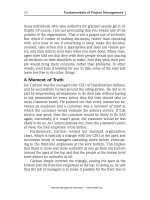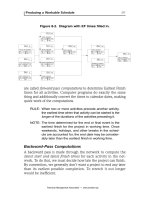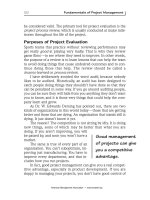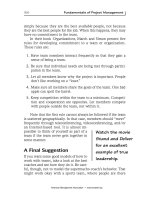HD Insight Succinctly by James Beresford
Bạn đang xem bản rút gọn của tài liệu. Xem và tải ngay bản đầy đủ của tài liệu tại đây (1.89 MB, 61 trang )
1
2
By
James Beresford
Foreword by Daniel Jebaraj
3
Copyright © 2014 by Syncfusion, Inc.
2501 Aerial Center Parkway
Suite 200
Morrisville, NC 27560
USA
All rights reserved.
mportant licensing information. Please read.
This book is available for free download from www.syncfusion.com upon completion of a
registration form.
If you obtained this book from any other source, please register and download a free copy
from www.syncfusion.com.
This book is licensed for reading only if obtained from www.syncfusion.com.
This book is licensed strictly for personal or educational use.
Redistribution in any form is prohibited.
The authors and copyright holders provide absolutely no warranty for any information
provided.
The authors and copyright holders shall not be liable for any claim, damages or any other
liability arising from, out of or in connection with the information in this book.
Please do not use this book if the listed terms are unacceptable.
Use shall constitute acceptance of the terms listed.
SYNCFUSION, SUCCINCTLY, DELIVER INNOVATION WITH EASE, ESSENTIAL and .NET
ESSENTIALS are the registered trademarks of Syncfusion, Inc.
Technical Reviewer: Buddy James
Copy Editor: Suzanne Kattau
Acquisitions Coordinator: Hillary Bowling, marketing coordinator, Syncfusion, Inc.
Proofreader: Darren West, content producer, Syncfusion, Inc.
I
4
Table of Contents
Table of Figures 6
The Story behind the Succinctly Series of Books 7
About the Author 9
Aims of this Book 10
Chapter 1 Platform Overview 11
Microsoft’s Big Data Platforms 11
Data Management and Storage 12
HDInsight and Hadoop 12
Chapter 2 Sentiment Analysis 14
A Simple Overview 14
Complexities 16
Chapter 3 Using the HDInsight Platform on Azure to Perform Simple Sentiment Analysis 17
Chapter 4 Configuring an HDInsight Cluster 18
Chapter 5 HDInsight and the Windows Azure Storage Blob 20
Loading Data into Azure Blob Storage 20
Referencing Data in Azure Blob Storage 21
Chapter 6 HDInsight and PowerShell 24
Chapter 7 Using C# Streaming to Build a Mapper 25
Streaming Overview 26
Streaming with C# 26
Data Source 26
Data Challenges 27
Data Spanning Multiple Lines 27
Inconsistent Formatting 29
5
Quoted Text 30
Words of No Value 31
Executing the Mapper against the Data Sample 32
Chapter 8 Using Pig to Process and Enrich Data 35
Using Pig 35
Referencing the Processed Data in a Relation 36
Joining the Data 38
Aggregating the Data 39
Exporting the Results 40
Additional Analysis on Word Counts 41
Chapter 9 Using Hive to Store the Output 43
Creating an External Table to Reference the Pig Output 43
Chapter 10 Using the Microsoft BI Suite to Visualize Results 45
The Hive ODBC Driver and PowerPivot 45
Installing the Hive ODBC Driver 45
Setting up a DSN for Hive 45
Importing Data into Excel 47
Adding Context in PowerPivot 49
Importing a Date Table from Windows Azure DataMarket 50
Creating a Date Hierarchy 51
Linking to the Sentiment Data 53
Adding Measures for Analysis 53
Visualizing in PowerView 55
PowerQuery and HDInsight 59
Other Components of HDInsight 60
Oozie 60
Sqoop 60
Ambari 60
6
Table of Figures
Figure 1: HDInsight from the Azure portal 18
Figure 2: Creating an HDInsight cluster 19
Figure 3: CloudBerry Explorer connected to Azure Storage 21
Figure 4: The Hadoop Command Line shortcut 35
Figure 5: Invoking the Pig Command Shell 36
Figure 6: DUMP output from Pig Command Shell 37
Figure 7: Pig command launching MapReduce jobs 41
Figure 8: ODBC apps 46
Figure 9: Creating a new System DSN using the Hive ODBC driver 46
Figure 10: Configuring the Hive DSN 47
Figure 11: The Excel PowerPivot Ribbon tab 47
Figure 12: Excel PowerPivot Manage Data Model Ribbon 48
Figure 13: Excel PowerPivot Table Import Wizard - Data Source Type selection 48
Figure 14: Excel PowerPivot Table Import Wizard - Data Link Type selection 48
Figure 15: Excel PowerPivot Table Import Wizard - Selecting Hive tables 49
Figure 16: Excel PowerPivot Data Model Diagram View 49
Figure 17: Excel PowerPivot Import Data from Data Service 50
Figure 18: Excel Windows Azure Marketplace browser 50
Figure 19: Excel Windows Azure Marketplace data feed options 51
Figure 20: Excel PowerPivot Data Model - Creating a hierarchy 52
Figure 21: Excel PowerPivot Data Model - Adding levels to a hierarchy 52
Figure 22: Adding a measure to the Data Model 54
Figure 23: Launching PowerView in Excel 55
Figure 24: PowerView fields browsing 56
Figure 25: PowerView sample report "Author name distribution" 57
Figure 26: PowerView sample report "Sentiment by Post Length" 58
Figure 27: PowerView sample report "Sentiment by Author over Time" 58
7
The Story behind the Succinctly Series
of Books
Daniel Jebaraj, Vice President
Syncfusion, Inc.
taying on the cutting edge
As many of you may know, Syncfusion is a provider of software components for
the Microsoft platform. This puts us in the exciting but challenging position of
always being on the cutting edge.
Whenever platforms or tools are shipping out of Microsoft, which seems to be
about every other week these days, we have to educate ourselves, quickly.
Information is plentiful but harder to digest
In reality, this translates into a lot of book orders, blog searches, and Twitter scans.
While more information is becoming available on the Internet and more and more books are
being published, even on topics that are relatively new, one aspect that continues to inhibit
us is the inability to find concise technology overview books.
We are usually faced with two options: read several 500+ page books or scour the web for
relevant blog posts and other articles. Just as everyone else who has a job to do and
customers to serve, we find this quite frustrating.
The Succinctly series
This frustration translated into a deep desire to produce a series of concise technical books
that would be targeted at developers working on the Microsoft platform.
We firmly believe, given the background knowledge such developers have, that most topics
can be translated into books that are between 50 and 100 pages.
This is exactly what we resolved to accomplish with the Succinctly series. Isn’t everything
wonderful born out of a deep desire to change things for the better?
The best authors, the best content
Each author was carefully chosen from a pool of talented experts who shared our vision. The
book you now hold in your hands, and the others available in this series, are a result of the
authors’ tireless work. You will find original content that is guaranteed to get you up and
running in about the time it takes to drink a few cups of coffee.
Free forever
Syncfusion will be working to produce books on several topics. The books will always be
free. Any updates we publish will also be free.
S
8
Free? What is the catch?
There is no catch here. Syncfusion has a vested interest in this effort.
As a component vendor, our unique claim has always been that we offer deeper and broader
frameworks than anyone else on the market. Developer education greatly helps us market
and sell against competing vendors who promise to “enable AJAX support with one click” or
“turn the moon to cheese!”
Let us know what you think
If you have any topics of interest, thoughts or feedback, please feel free to send them to us
at
We sincerely hope you enjoy reading this book and that it helps you better understand the
topic of study. Thank you for reading.
Please follow us on Twitter and “Like” us on Facebook to help us spread the
word about the Succinctly series!
9
About the Author
James Beresford is a certified Microsoft Business Intelligence (BI) Consultant who has been
working with the platform for over a decade. He has worked with all aspects of the stack, his
specialty being extraction, transformation, and load (ETL) with SQL Server Integration
Services (SSIS) and Data Warehousing on SQL Server. He has presented twice at TechEd
in Australia and is a frequent presenter at various user groups.
His client experience includes companies in the insurance, education, logistics and banking
fields. He first used the HDInsight platform in its preview stage for a telecommunications
company to analyse unstructured data, and has watched the platform grow and mature since
its early days.
He blogs at www.bimonkey.com and tweets @BI_Monkey. He can be found on LinkedIn at
10
Aims of this Book
HDInsight Succinctly aims to introduce the reader to some of the core concepts of the
HDInsight platform and explain how to use some of the tools it makes available to process
data. This will be demonstrated by carrying out a simple Sentiment Analysis process against
a large volume of unstructured text data.
This book has been written from the perspective of an experienced BI professional and,
consequently, part of this book’s focus is on translating Hadoop concepts in those terms as
well as on translating Hadoop tools to more familiar languages such as Structured Query
Language (SQL) and MultiDimensional eXpressions (MDX). Experience in either of these
languages is not required to understand this book but, for those with roots in the relational
data world, experience in these languages will help in understanding its content.
Throughout the course of this book, the following features will be demonstrated:
Setting up and managing HDInsight clusters on Azure
The use of Azure Blob Storage to store input and output data
Understanding the role of PowerShell in managing clusters and executing jobs
Running MapReduce jobs written in C# on the HDInsight platform
The higher-level languages Pig and Hive
Connecting with Microsoft BI tools to retrieve, enrich, and visualize the output
The example process will not cover all the features available in HDInsight. In a closing
chapter, the book will review some of the features not previously discussed so the reader will
have a complete view of the platform.
It is worth nothing that the approaches used in this book are not designed to be optimal for
performance or process time, as the aim is to demonstrate the capabilities of the range of
tools available rather than focus on the most efficient way to perform a specific task.
Performance considerations are significant as they will impact not just how long a job takes
to run but also its cost. A long-running job consumes more CPU and one that generates a
large volume of data—even as temporary files—will consume more storage. When this is
paid for as part of a cloud service, the costs can soon mount up.
11
Chapter 1 Platform Overview
Microsoft’s Big Data Platforms
The world of data is changing in a big way and expectations about how to interact and
analyze that data are changing as a result. Microsoft offers a broad and scalable portfolio of
data storage capabilities for structured, unstructured, and streaming data—both on-premises
and in the cloud.
Microsoft has been present in the traditional BI space through the SQL Server platform
which scales quite satisfactorily into the hundreds of gigabytes range without too much need
for specialist hardware or clever configuration. Since approximately 2010, Microsoft has also
offered a couple of specialist appliances to scale higher: the SQL Server Fast Track Data
Warehouse for anything up to 100 terabytes, and the SQL Server Parallel Data Warehouse
(PDW) for anything entering the petabyte scale.
However, these platforms only deal with relational data and the open-source movement
overtook Microsoft (and indeed many other vendors) with the emergence of Hadoop.
Microsoft did have a similar platform internally called Dryad but, shortly before Dryad was
expected to go live, it was dropped in favor of creating a distribution of Hadoop in
conjunction with Hortonworks.
1
2
From that decision point, various previews of the platform were made available as on-
premises or cloud versions. Early in 2013, the HDInsight name was adopted for the preview
(replacing the original “Hadoop on Azure” name) and the cloud platform became generally
available in October 2013. The on-premises version is, at the time of this writing, still in
preview with no firm release date.
Aspects of these technologies are working their way back into the relational world: The 2.0
version of the Parallel Data Warehouse features support for Hadoop including a language
called PolyBase that allows queries to include relational and nonrelational data in the same
statements.
3
1
Dryad Project page:
2
ZDNet - Microsoft drops Dryad; puts its big-data bets on Hadoop:
3
PolyBase - />warehousing/polybase.aspx
12
Data Management and Storage
Data management needs have evolved from traditional relational storage to both relational
and nonrelational storage, and a full-spectrum information management platform needs to
support all types of data. To deliver insight on any data, a platform is needed that provides a
complete set of capabilities for data management across relational, nonrelational and
streaming data. The platform needs to be able to seamlessly move data from one type to
another, and be able to monitor and manage all data regardless of the type of data or data
structure it is. This has to occur without the application having to worry about scale,
performance, security, and availability.
In addition to supporting all types of data, moving data to and from a nonrelational store
(such as Hadoop) and a relational data warehouse is one of the key Big Data customer
usage patterns. To support this common usage pattern, Microsoft provides connectors for
high-speed data movement between data stored in Hadoop and existing SQL Server Data
Warehousing environments, including SQL Server Parallel Data Warehouse.
There is a lot of debate in the market today over relational vs. nonrelational technologies.
Asking the question, “Should I use relational or nonrelational technologies for my application
requirements?” is asking the wrong question. Both are storage mechanisms designed to
meet very different needs and the two should be considered as complementary.
Relational stores are good for structured data where the schema is known, which makes
programming against a relational store require an understanding of declarative query
languages like SQL. These platforms deliver a store with high consistency and transaction
isolation.
In contrast, nonrelational stores are good for unstructured data where schema does not exist
or where applying it is expensive and querying it is more programmatic. This platform gives
greater flexibility and scalability—with a tradeoff of losing the ability to easily work with the
data in an ACID manner; however, this is not the case for all NoSQL databases (for
example, RavenDB).
As the requirements for both of these types of stores evolve, the key point to remember is
that a modern data platform must support both types of data equally well, provide unified
monitoring and management of data across both, and be able to easily move and transform
data across all types of stores.
HDInsight and Hadoop
Microsoft’s Hadoop distribution is intended to bring the robustness, manageability, and
simplicity of Windows to the Hadoop environment.
For the on-premises version, that means a focus on hardening security through integration
with Active Directory, simplifying manageability through integration with System Center, and
dramatically reducing time to set up and deploy via simplified packaging and configuration.
These improvements will enable IT to apply consistent security policies across Hadoop
clusters and manage them from a single pane of glass on System Center.
For the service on Windows Azure, Microsoft will further lower the barrier to deployment by
enabling the seamless setup and configuration of Hadoop clusters through easy to use
components of the Azure management portal.
13
Finally, they are not only shipping an open source-based distribution of Hadoop but are also
committed to giving back those updates to the Hadoop community. Microsoft is committed to
delivering 100-percent compatibility with Apache Hadoop application programming interfaces
(APIs) so that applications written for Apache Hadoop should work on Windows.
Working closely with Hortonworks, Microsoft has submitted a formal proposal to contribute
the Hadoop-based distribution on Windows Azure and Windows Server as changes to the
Apache code base.
4
In addition, they are also collaborating on additional capabilities such as
Hive connectivity, and an innovative JavaScript library developed by Microsoft and
Hortonworks to be proposed as contributions to the Apache Software Foundation.
Hortonworks is focused on accelerating the development and adoption of Apache Hadoop.
Together with the Apache community, they are making Hadoop more robust and easier to
use for enterprises, and more open and extensible for solution providers.
As the preview has passed through, various features have come and gone. An original
feature was the Console, a friendly web user interface that allowed job submission, access
to Hive, and a JavaScript console that allowed querying of the File system and submission of
Pig jobs. This functionality has gone but is expected to migrate into the main Azure Portal at
some time (though what this means for the on-premises version is unclear). However, in its
place has appeared a fully featured set of PowerShell cmdlets that allows remote
submission of jobs and even creation of clusters.
One feature that has remained has been the ability to access Hive directly from Excel
through an Open Database Connectivity (ODBC) driver. This has enabled the consumption
of the output of Hadoop processes through an interface with which many users are familiar,
and connects Hadoop with the data mashup capabilities of PowerPivot and rich
visualizations of PowerView.
The platform continues to evolve and features are constantly arriving (and occasionally
going). This book will do its best to capture the current state but, even as it was being
written, content needed to be updated to deal with the ongoing changes.
4
Hortonworks company website:
14
Chapter 2 Sentiment Analysis
To help get a grasp on the tools within HDInsight we will demonstrate their usage through a
applying a simple Sentiment Analysis process to a large volume of unstructured text data. In
this short non-technical section we will look at what Sentiment Analysis is. As part of this a
simple approach will be set down which is the one that will be used as we progress through
our exploration of HDInsight.
A Simple Overview
Sentiment Analysis is the process of deriving emotional context from communications
through analyzing the words and terms used in those communications. This can be spelled
out in the simple example below:
Step 1: Take some simple free-form text such as text from a hotel review:
Title
Hotel Feedback
Content
I had a fantastic time on holiday at your resort. The service was excellent and
friendly. My family all really enjoyed themselves.
The pool was closed, which kind of sucked though.
Step 2: Take a list of words deemed as “positive” or “negative” in Sentiment:
Positive
Negative
Good
Bad
Great
Worse
Fantastic
Rubbish
Excellent
Sucked
Friendly
Awful
Awesome
Terrible
Enjoyed
Bogus
Step 3: Match the text to the Sentiment word list:
15
Title
Hotel Feedback
Content
I had a fantastic time on holiday at your resort. The service was excellent and
friendly. My family all really enjoyed themselves.
The pool was closed, which kind of sucked though.
Step 4: Count the Sentiment words in each category:
Positive
Negative
Fantastic
Sucked
Excellent
Friendly
Enjoyed
4
1
Step 5: Subtract the negative from the positive:
Positive Sentiment
4
Negative Sentiment
1
Overall Sentiment
3
In this example, the overall result is that the Sentiment of this particular block of text is
positive and an automated system could interpret this as a positive review.
16
Complexities
The view presented above is a very simplistic approach to Sentiment Analysis, as it
examines individual words free of context and decides whether they are positive or negative.
For example, consider this paragraph:
“I think you misunderstand me. I do not hate this and it
doesn’t make me angry or upset in any way. I just had a
terrible journey to work and am feeling a bit sick.”
By examining it using human ability to derive context, this is not a negative comment at all; it
is quite apologetic. But it is littered with words that, assessed in isolation, would present a
view that was very negative. Simple context can be added by considering the influence of
modifying words such as “not”, though this has an impact on processing time. More complex
context starts entering the domain of Natural Language Processing (NLP) which is a deep
and complicated field that attempts to address these challenges.
A second issue is in the weight that is given to particular words. “Hate” is a stronger
expression of dislike than “dislike” is—but where on that spectrum are “loathe” and “sucks”?
A given person’s writing style would also impact the weight of such words. Someone prone
to more dramatic expressions may declare that they “hate” something that is just a minor
inconvenience, when a more diplomatic person may state that they are “concerned” about
something that actually has caused them great difficulty.
This can be addressed in a couple of ways. The first way is to set aside the individual’s style
and apply weighting to specific words according to a subjective judgment. This, of course,
presents the challenge that the list of words will be long and, therefore, assigning weights
will be a time-consuming effort. Also, it is quite probable that not all the words will be
encountered in the wild. The second way—and one that reflects a technique used in the
analytical world when addressing outcomes on a scale that is not absolute—is to simply use
a simplistic approach that allocates a word as positive, negative or, in the absence of a
categorization, neutral—and set the scale issue to one side.
A third issue is the distribution and use of words in a given scenario. In some cases, words
that are common in the domain being analyzed may give false positives or negatives. For
example, a pump manufacturer looking at reviews of its products should not be accounting
for the use of the word “sucks” as it is a word that would feature in descriptions of those
products’ capabilities. This is a simpler issue to address as, like part of any Sentiment
Analysis, it is important to review the more frequent words that are impacting Sentiment in
case words are being assessed as doing so when they are actually neutral in that specific
domain.
For further reading on this field, it is recommended you look at the work of University of
Illinois professor Bing Liu (an expert in this field) at
17
Chapter 3 Using the HDInsight Platform
on Azure to Perform Simple Sentiment
Analysis
In this book, we will be discussing how to perform a simple, word-based Sentiment Analysis
exercise using the HDInsight platform on Windows Azure. This process will consist of
several steps:
Creating and configuring an HDInsight cluster
Uploading the data to Azure Blob Storage
Creating a Mapper to decompose the individual words in a message using C#
streaming
Executing that Mapper as a Hadoop MapReduce job
Using Pig to:
o apply Sentiment indicators to each word within a message
o aggregate the Sentiment across messages and words
o exporting the aggregated results back to Azure Blob Storage
Using Hive to expose the results to ODBC
Adding context using PowerPivot
Visualizing using PowerView
18
Chapter 4 Configuring an HDInsight
Cluster
Configuring an HDInsight cluster is designed to be an exercise that demonstrates the true
capacity of the cloud to deliver infrastructure simply and quickly. The process of provisioning
a nine-node cluster (one head node and eight worker nodes) can take as little as 15 minutes
to complete.
HDInsight is delivered as part of the range of services available through the Windows Azure
platform. HDInsight was formally launched as a publicly available service in October 2013.
Once access to the program is granted, HDInsight appears in the selection of available
services:
Figure 1: HDInsight from the Azure portal
To create a cluster, select the HDInsight Service option and you will be directed to create
one. To do so, you will be directed to the Quick Create option which will create a cluster
using some basic presets. Cluster sizes are available from four nodes to 32 nodes. You will
need an Azure storage account in the same region as your HDInsight cluster to hold your
data. This will be discussed in a later section.
19
Figure 2: Creating an HDInsight cluster
While you may be tempted to create the biggest cluster possible, a 32-node cluster could
cost US$261.12 per day to run and may not necessarily give you a performance boost
depending on how your job is configured.
5
If you opt to custom create, you gain flexibility over selecting your HDInsight version, exact
number of nodes, location, ability to select Azure SQL for a Hive and Oozie metastore, and
finally, more options over storage accounts including selecting multiple accounts.
5
As per pricing quoted at time of writing from: />us/pricing/details/hdinsight/
20
Chapter 5 HDInsight and the Windows
Azure Storage Blob
Loading Data into Azure Blob Storage
The HDInsight implementation of Hadoop can reference the Windows Azure Storage Blob
(WASB) which provides a full-featured Hadoop Distributed File System (HDFS) over Azure
Blob Storage.
6
This separates the data from compute nodes. This conflicts with the general
Hadoop principle of moving the data to the compute in order to reduce network traffic, which
is often a performance bottleneck. This bottleneck is avoided in WASB as it streams data
from Azure Blob Storage over the fast Azure Flat Network Storage—otherwise known as the
“Quantum 10” (Q10) network architecture)—which ensures high performance.
7
This allows you to store data on cheap Azure Storage rather than maintaining it on the
significantly more expensive HDInsight cluster’s compute nodes’ storage. It further allows for
the relatively slow process of uploading data to precede launching your cluster and allows
your output to persist after shutting down the cluster. This makes the compute component
genuinely transitional and separates the costs associated with compute from those
associated with storage.
Any Hadoop process can then reference data on WASB and, by default, HDInsight uses it
for all storage including temporary files. The ability to use WASB applies to not just base
Hadoop functions but extends to higher-level languages such as Pig and Hive.
Loading data into Azure Blob Storage can be carried out by a number of tools. Some of
these are listed below:
Name
GUI
Free
Source
AzCopy
No
Yes
/>2/12/03/azcopy-uploading-downloading-files-for-windows-
azure-blobs.aspx
Azure Storage
Explorer
Yes
Yes
CloudBerry Explorer
for Azure Storage
Yes
Yes
/>explorer.aspx
6
Azure Vault Storage in HDInsight: A Robust and Low Cost Storage Solution:
/>low-cost-storage-solution.aspx
7
Why use Blob Storage with HDInsight on Azure: />storage-with-hdinsight-on-azure/
21
Name
GUI
Free
Source
CloudXplorer
Yes
No
Windows and SQL
Azure tools for .NET
professionals
Yes
No
A screenshot of CloudBerry Explorer connected to the Azure Storage being used in this
example is below:
Figure 3: CloudBerry Explorer connected to Azure Storage
As you can see, it is presented very much like a file explorer and most of the functionality
you would expect from such a utility is available.
Uploading significant volumes of data for processing can be a time-consuming process
depending on available bandwidth, so it is recommended that you upload your data before
you set up your cluster as these tasks can be performed independently. This stops you from
paying for compute time while you wait for data to become available for processing.
Referencing Data in Azure Blob Storage
The approach to referencing data held in the WASB depends on the configuration of the
HDInsight instance.
22
When creating the HDInsight cluster in the Management Portal using the Quick Create
option, you specify an existing storage account. Creating the cluster will also cause a new
container to be created in that account. Using Custom Create, you can specify the container
within the storage account.
Normal Hadoop file references look like this:
hdfs://[name node path]/directory level 1/directory level
2/filename
eg:
hdfs://localhost/user/data/big_data.txt
WASB references are similar except, rather than referencing the name node path, the Azure
Storage container needs to be referenced:
wasb[s]://[<container>@]<accountname>.blob.core.windows.net/
<path>
eg:
wasb:///us
er/data/big_data.txt
For the default container, the explicit account/container information can be dropped, for
example:
hadoop fs -ls wasb://user/data/big_data.txt
It is even possible to drop the wasb:// reference as well:
hadoop fs –ls user/data/big_data.txt
Note the following options in the full reference:
* wasb[s]: the [s] allows for secure connections over SSL
* The container is optional for the default container
The second point is highlighted because it is possible to have a number of storage accounts
associated with each cluster. If using the Custom Create option, you can specify up to seven
additional storage accounts.
If you need to add a storage account after cluster creation, the configuration file core-site.xml
needs to be updated, adding the storage key for the account so the cluster has permission to
read from the account using the following XML snippet:
23
<property>
<name>fs.azure.account.key.[accountname].blob.core.windows.net</name
>
<value>[accountkey]</value> </property>
Complete documentation can be found on the Windows Azure website.
8
As a final note, the wasb:// notation is used in the higher-level languages (for example, Hive
and Pig) in exactly the same way as it is for base Hadoop functions.
8
Using Windows Azure Blob Storage with HDInsight: />us/manage/services/hdinsight/howto-blob-store/
24
Chapter 6 HDInsight and PowerShell
PowerShell is the Windows scripting language that enables manipulation and automation of
Windows environments.
9
It is an extremely powerful utility that allows for execution of tasks
from clearing local event logs to deploying HDInsight clusters on Azure.
When HDInsight went into general availability, there was a strong emphasis on enabling
submission of jobs of all types through PowerShell. One motivation behind this was to avoid
some of the security risks associated with having Remote Desktop access to the head node
(a feature now disabled by default when a cluster is built, though easily enabled through the
portal). A second driver was to enable remote, automated execution of jobs and tasks. This
gives great flexibility in allowing efficient use of resources. Say, for example, web logs from
an Azure-hosted site are stored in Azure Blob Storage and, once a day, a job needs to be
run to process that data. Using PowerShell from the client side, it would be possible to spin
up a cluster, execute any MapReduce, Pig or Hive jobs, and store the output somewhere
more permanent such as a SQL Azure database—and then shut the cluster back down.
To cover PowerShell would take a book in itself, so here we will carry out a simple overview.
More details can be found on TechNet.
10
PowerShell’s functionality is issued through cmdlets. These are commands that accept
parameters to execute certain functionality.
For example, the following cmdlet lists the HDInsight clusters available in the specified
subscription in the console:
Get-AzureHDInsightCluster -Subscription $subid
For job execution, such as committing a Hive job, cmdlets look like this:
Invoke-Hive "select * from hivesampletable limit 10"
These act in a very similar manner to submitting jobs directly via the command line on the
server.
Full documentation of the available cmdlets is available on the Hadoop (software
development kit (SDK) page on CodePlex.
11
Installing the PowerShell extensions is a simple matter of installing a couple of packages
and following a few configuration steps. These are captured in the official documentation.
12
9
Scripting with Windows PowerShell:
10
Windows PowerShell overview: />us/library/cc732114%28v=ws.10%29.aspx
11
Microsoft .NET SDK for Hadoop:
12
Install and configure PowerShell for HDInsight: />us/documentation/services/hdinsight/
25
Chapter 7 Using C# Streaming to Build a
Mapper
A key component of Hadoop is the MapReduce framework for processing data. The concept
is that execution of the code that processes the data is sent to the compute nodes, which is
what makes it an example of distributed computing. This work is split across a number of
jobs that perform specific tasks.
The Mappers’ job is equivalent to the extract components of the ETL paradigm. They read
the core data and extract key information from it, in effect imposing structure on the
unstructured data. As an aside, the term “unstructured” is a bit of a misnomer in that the data
is not without structure altogether—otherwise it would be nearly impossible to parse. Rather,
the data does not have structure formally applied to it as it would in a relational database. A
pipe delimited text file could be considered unstructured in that sense. So, for example, our
source data may look like this:
1995|Johns, Barry|The Long Road to
Succintness|25879|Technical
1987|Smith, Bob|I fought the data and the data
won|98756|Humour
1997|Johns, Barry|I said too little last
time|105796|Fictions
A human eye may be able to guess that this data is perhaps a library catalogue and what
each field is. However, a computer would have no such luck as it has not been told the
structure of the data. This is, to some extent, the job of the Mapper. It may be told that the
file is pipe delimited and it is to extract the Author’s Name as a Key and the Number of
Words as the Value as a <Key,Value> pair. So, the output from this Mapper would look like
this:
[key] <Johns, Barry> [value] <25879>
[key] <Smith, Bob> [value] <98756>
[key] <Johns, Barry> [value] <105796>
The Reducer is equivalent to the transform component of the ETL paradigm. Its job is to
process the data provided. This could be something as complex as a clustering algorithm or
something as simple as aggregation (for instance, in our example, summing the Value by the
Key), for example:
[key] <Johns, Barry> [value] <131675>
[key] <Smith, Bob> [value] <98756>
There are other components to this process, notably Combiners which perform some
functions of the Reducer task on an individual Mapper’s node. There are also Partitioners
which designate where Reducer output gets sent for Reducers to process. For full details,
refer to the official documentation at









